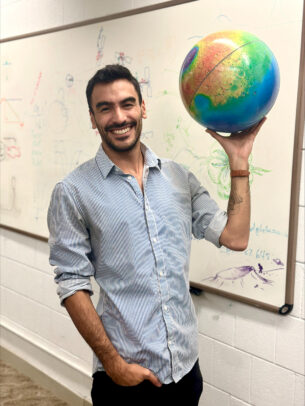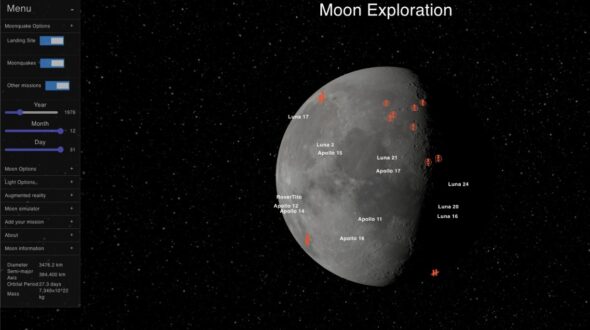UIC student designs moon app as part of winning NASA competition team

Doctoral student Juan Manuel Losarcos came from Argentina to University of Illinois Chicago to study the geology of planets, hoping to pave the route for future space colonists. Now, as part of a team that designed a prize-winning app to virtually explore the moon, he’ll get the chance to visit his dream employer: NASA.
With a group of friends from Argentina, Losarcos developed Aónikenk, a 3D interactive visualization of the moon that allows users to view geological data and information about past moon missions, experience a simulated “moonquake” and ask a chatbot questions about our lunar neighbor. The project received the Best Use of Technology award at the 2023 NASA International Space Apps Challenge.
The work complements Losarcos’ studies in planetary science at UIC, where he is mentored by Andrew Dombard, professor of earth and environmental sciences.
“I’m really interested in trying to understand the geological history of the moon and Mars,” Losarcos said. “For my research, I am trying to find lava tubes – caves on the subsurface of the moon and Mars that might work as shelter for human colonies in the future.”
That geological focus made him a perfect candidate for the NASA app challenge, which asked teams to build an “interactive 3D digital moon globe” based on seismic data transmitted from instruments left behind by Apollo astronauts. To do so, he reunited with a group of engineers from his home country with whom he previously designed an open-source moon rover named RoverTito.
The RoverTito design, which won a different competition in 2021, focused on building hardware that could survive a mission to space. But the goal of Aónikenk was closer to home: educating the public about the geology of the moon. The model uses publicly available tools such as video-game graphics and artificial-intelligence language models to create an immersive, accessible experience.
Winning teams will be honored this summer at a ceremony in Washington, D.C., where Losarcos is “very, very enthusiastic” about the chance to visit NASA headquarters for the first time. He’s also excited to bring the new technical and scientific knowledge he gathered during the challenge into his research at UIC.
“I’m very happy to be here learning about something that I’m really passionate about,” Losarcos said. “I was the kind of kid who spent hours seeing the stars and watching documentaries about planets, and now I am trying to pursue my dreams right here.”

